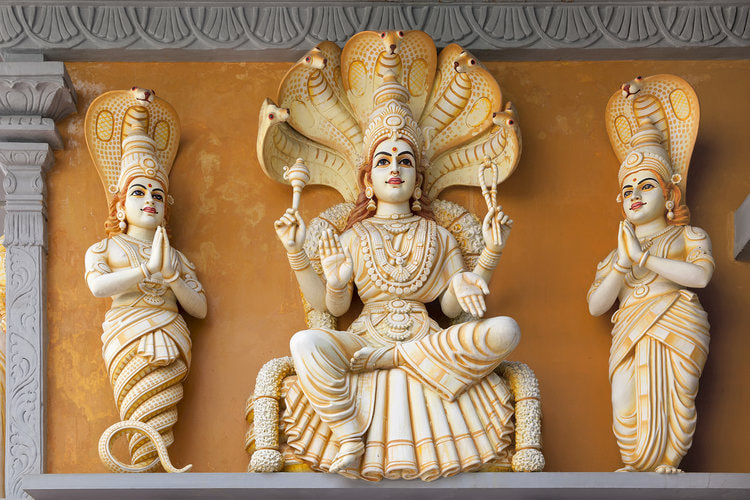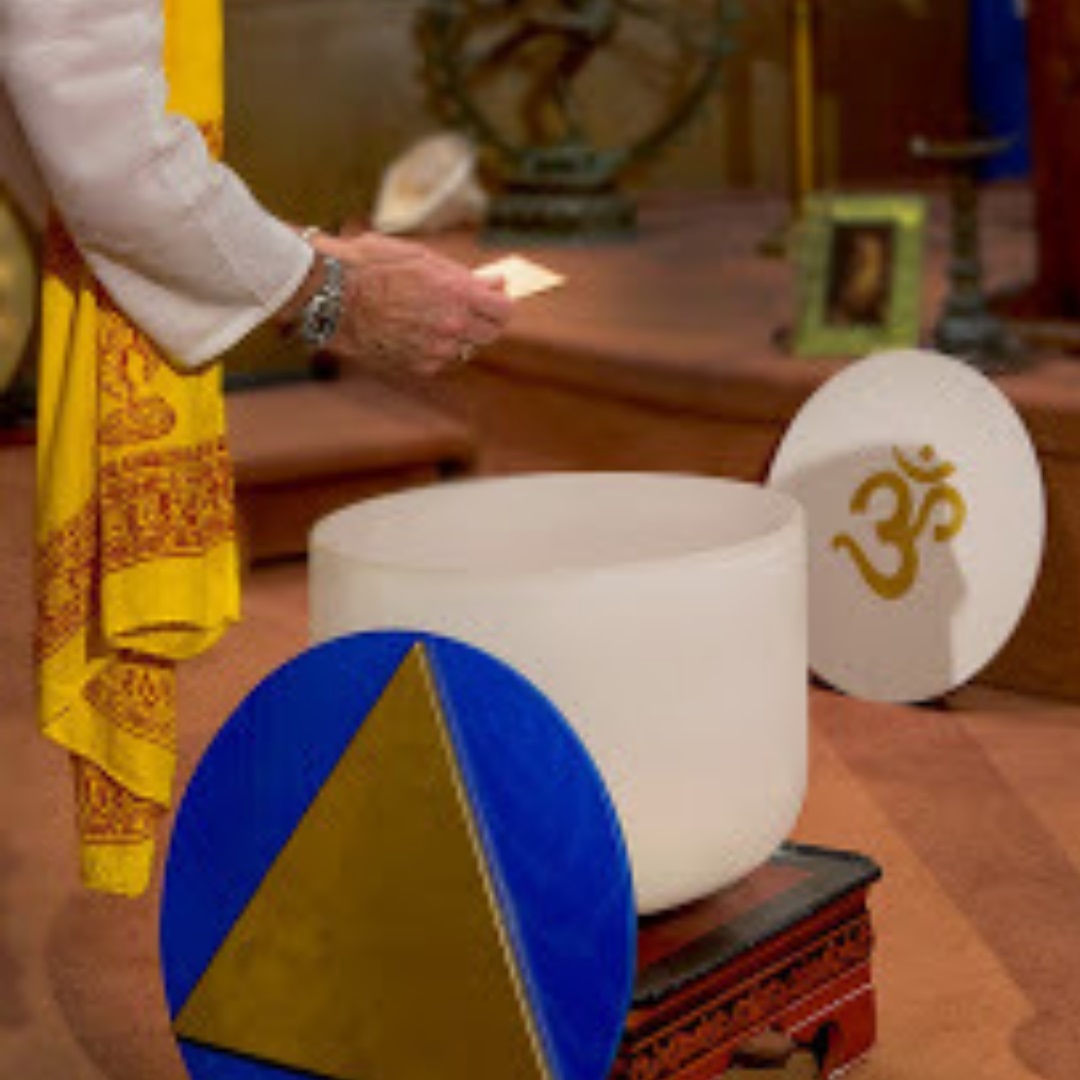The word “kriya” is from the Sanskrit root “kri” which means “to do”. It implies an action, rite or ritual, hopefully one that is performed consciously. So sometimes it refers to a technique like your pranayama or the shat kriyas, which are purification techniques. It is also used to describe and discuss the currents within the subtle body, sometimes called kriya currents.
Yoga means to join together. It is the integration of one’s own consciousness with universal or cosmic consciousness. Goswami Kriyananda defines Yoga as “that state when your life of action and thought are in harmony with the very source of your being. It is a psychosomatic relationship, a functioning on the profoundest level of your consciousness beyond the limits of thought and language.” As this definition implies, yoga is much more than an ancient body of knowledge. Yoga is a verb — a doing and a way of living.
Kriya Yoga is the only yoga discussed by Patanjali in his Yoga Sutras In book II, sutra I, he states “Tapaha Svadhyaya Ishvara-Pranidhana Kriya Yogaha.” This translates “Kriya Yoga is self-discipline (tapas), self-study (svadhyaya), and attunement to Life.”
Kriya is a system which deals directly with the mind, its structure and dynamics. Embodied within it is a mystical psychology which offers a profound recognition of how we create, sustain and dissolve the circumstances of our life. Its unique approach is rooted in its focus on karma, the laws of causation, and how karma is generated, activated and can be softened and modified. Kriya is a way of self-study and meditative attunement which induces a direct perception or insight into the nature of consciousness, the pattern of your mind and of life itself.

Kriya encompasses all eight limbs of the classical yoga system as presented by Patanjali in his work, “The Yoga Sutras.” Patanjali’s Yoga Sutras, as you may know, is a text that codified what was already an oral tradition for thousands of years before it was committed to writing over 2500 years ago. One of the primary and fundamental limbs of the Patanjali system is Hatha Yoga, the ability to form and hold a still posture while regulating the breath. The implication is that to sustain physical and mental health, a stillness of the body and mind are essential. Without this fundamental skill and the benefits of its practice, deeper and advanced yoga techniques are difficult to master.
Kriya Yoga embraces the perennial truths that pervade all of the world’s mystical traditions, uniting the diversity of cultural and historical expressions into a harmonious, living practice. It is a system for experiencing a transformation of consciousness, which enriches one’s life on every level.
The fundamentals of Kriya Yoga, as taught by Goswami Kriyananda, include striving to be a sage, not a saint, finding joy and wisdom in life and realizing that there is no cookbook. Everyone is unique. Therefore, seekers must find their own paths and determine what is helpful to them. This can be done by quieting the mind, softening karma and being truthful with oneself. Begin the journey with happiness. Learn to meditate and be comfortable in this world. Enjoy life and find it meaningful.
The ancient practice of Kriya Yoga is delineated in Patanjali’s Yoga Sutras. It was revived in 1861 when Babaji gave the teachings to Lahiri Mahasaya. Lahiri Mahasaya taught Sri Yukteswar who taught Paramahansa Yogananda. Paramahansa Yogananda brought Kriya Yoga to the West in 1920. Sri Shelliji was taught by Paramahansa Yogananda and the founder of the Temple of Kriya Yoga, Goswami Kriyananda, was taught by Sri Shelliji.
Meditation is a key yoga technique for expanding one’s horizon of awareness and Awakening to Life. Much of our time is spent on automatic, stuck in habitual patterns of thought and action that, in large part, were established in the first few years of life. Meditation is a means of coming-off-of-automatic, becoming less reactive, and seeing more clearly.
As we meditate, we begin to awaken to the extent that we are living from patterns of the past, and we develop our capacity to respond to life with intention and with less emotional reactivity. We create spaces between our thoughts and actions such that we can make conscious, intentional choices rather than be driven by the habitual patterns of the past.
As we continue to meditate, we realize how much of our time we have been guarding ourselves against some hurt from the past, and we grow in our capacity to open our hearts in unselfish love toward others and toward ourselves. With a daily meditation practice, we notice gradual improvements in the way we relate to our life circumstances, to other sentient beings, and to ourselves. A consistent meditation practice will lead, in time, to an experience of samadhi and the realization of our true Self.

Meditation practice should be performed daily, and at a consistent time and place. Initially, the duration of practice might be for just a few minutes. Some basic instructions for one meditation technique are to sit upright, close your eyes and be “at attention without tension.” Let your consciousness come to rest at the point between the eyebrows (the ajna chakra). Turn your head to the left and expel your breath twice vigorously with a “ha ha” sound (resurrection breath). Bring your head back to center and begin to simply watch your breath, noy trying to control the breath, simply observing it. One of the important steps on the spiritual path is developing our capacity to attend and be present, without feeling compelled to control. This is an aspect of what we are practicing with this meditation technique. When you become aware of a thought, simply notice the thought and return the attention to the breath. Do this for just a minute or two and you may feel more relaxed and content. Don’t force yourself to meditate for too long. You should look forward to your meditation. If meditation becomes a chore then you are more likely to avoid it, or give it up altogether. The duration is less important than sustaining a regular, daily practice. Five minutes each day is far better than thirty minutes once-a-week. Eventually your meditation practice will lengthen on its own and you will experience deeper levels of awareness and increasing feelings of contentment.
Hatha Yoga is often thought of as the stretching exercises (asanas) that most people in western society refer to simply as “yoga”. Kriya Yoga teaches us that we are more than our physical body, and Hatha Yoga in its purest form works with the entire mind/body complex. Among its many mystical benefits, Hatha Yoga can help us feel more at ease in the physical body.
Our body organs are linked to corresponding areas of our astral body. The astral (subtle) body contains “nadis” and “chakras”. Nadis are astral channels that control the flow of life energies. We refer to this life energy as “prana”. Prana is the subtle energy that maintains and animates all life. The more prana that flows throughout our being the better we will function and the healthier we will be: mentally, physically, and spiritually.
There are 7 primary astral energy centers (chakras) that exist in the vertical axis of our cerebro-spinal system. Hatha Yoga practice benefits the astral body by allowing prana to better flow through the nadis to nourish and balance the chakras. The proper practice of Hatha Yoga results in a much more comprehensive benefit than a physical exercise regimen that makes our body feel looser and more relaxed.

Goswami Kriyananda has said that our earth body is our most important piece of karma. Regular and properly performed, Hatha Yoga will help maintain and improve the functioning of the physical and astral bodies. Importantly, an optimally functioning physical body allows us to more effectively employ other important yogic techniques, such as meditation, with greater effectiveness.
The nature and structure of human astral physiology is taught in greater detail in the Kriya Yoga teachings.
Spiritual guidance is the opportunity to communicate privately with a priest of the Temple. You may ask any question about spiritual matters, or seek spiritual care. All of our Swamis are graduates of the seminary program and have been trained in pastoral guidance. You could also use this time to ask any questions about the Temple or the practices of Kriya Yoga.
Who may seek spiritual guidance?
All are welcome. Those of any faith or practice, from within our community or elsewhere. This service is free for all those who may need. LEARN MORE

A swami is an ordained yogic priest. The priesthood is an authorization to teach Truth, to perform the rites of the Temple, as well as to organize churches. A candidate for the priesthood can be ordained into the swamihood, at anytime after a suitable period of study has been completed under a person who has reached the title of guru, mahaswami or goswami. Upon ordination a swami is duly authorized to perform the rituals of baptism, house blessing, marriage, commitment, death-rebirth, funerals and other services as needed. Swamis ordained after study through the Temple of Kriya Yoga Seminary are independent of the Temple and responsible for establishing the direction of their priestly activities.
There are two orders of swamis: a swami who is a householder and a swami-brahmacharya who has taken the vow of celibacy, poverty and obedience. The swamis ordained after study through the Temple of Kriya Yoga, are primarily householder swamis dedicating their lives to service while living within a family environment. It is to be understood that neither is higher nor greater than the other.
Ordination to swamihood is not instituted to build up a religious hierarchy, for that would be in direct conflict with the fundamental principle of mysticism and ordination. Ordination, rather, is the laying upon a candidate of new and greater responsibilities. The ordained swami is not exalted to a place of special privilege, but is consecrated to a life of devotion to the Divine and special teaching to the world.

The first step to becoming a swami is to turn inward, and in the silence, listen to hear if you are drawn to a life of service. If your heart hears the call, the Temple of Kriya Yoga Seminary may be the place for you to answer.
The Temple Seminary is a program of study which unfolds over the period of approximately 2.5 years. There are 8 quarters of study in the form of audio lessons, reading assignments, exams, monthly conference calls, and annual retreats. A practice of personal spiritual discipline, meditation and prayer is also a required part of seminary studies.
Studies will cover topics such as the Bhagavad Gita, Upanishads, Kriya Yoga Sutras, meditation, dreams, symbolism, astrology, the laws of karma, Sanskrit, world religions, mysticism, hatha yoga, spiritual guidance, rituals and pastoral care. Course requirements include a final written paper on a topic related to eastern mystical thought, as well as a final oral exam covering the material studied over the course of the seminary program.

Above and beyond these requirements the seminarian must demonstrate maturity and readiness to assume responsibility to serve all life. The determination of that readiness is assessed over the course of the program and in a final interview with the head of the seminary program.
If you are drawn to this path, please read more about the program under the seminary section of our website. You may write or call the Temple to schedule a conversation with the swami responsible for leading the Seminary.
You are a part of life not apart from it. Astrology is both a science and spiritual art. Thru astrology you can know the meaning, nature and purpose of life. It is the language of symbolism opening the depth of the subconscious. Astrology does not work so much with mechanisms but with relationships, patterns, tendencies, and interpretations. It does not always give a yes or no answer. Astrology reveals patterns and tendencies in our life, however the planets incline, they do not compel.
The term means dispeller of darkness; a spiritual preceptor who takes on the responsibility of the spiritual unfoldment of another soul. The term guru has been hijacked in modern western society to apply to an expert, teacher or one having a unique skill set to impart to another. These all are true of a traditional guru in the guru-disciple relationship but it is much more. The guru-discipleship relationship awakens in the disciple the realization that the universe is a family of Oneness and all are intimately linked together. A mere teacher can have tremendous power to influence minds but does not have the power nor ability as does the guru to enlighten souls.
A disciple feeds the “body of the guru”, not the physical body, but the embodied spiritual truth that the guru is transmitting to the disciple so that they may attain enlightenment. A disciple is one who takes a vow to cultivate the self-discipline that is required of those walking the spiritual path. Initiation is central to discipleship. It is the disciple’s responsibility to become mentally, physically and spiritually prepared for initiation. The guru does not interfere with another person’s freedom. The exception is when the disciple states “my dream has become a nightmare, please help me. You can disturb my dream so that I might awaken unto Reality.”

The word “kriya” is from the Sanskrit root “kri” which means “to do”. It implies an action, rite or ritual, hopefully one that is performed consciously. So sometimes it refers to a technique like your pranayama or the shat kriyas, which are purification techniques. It is also used to describe and discuss the currents within the subtle body, sometimes called kriya currents.
Yoga means to join together. It is the integration of one’s own consciousness with universal or cosmic consciousness. Goswami Kriyananda defines Yoga as “that state when your life of action and thought are in harmony with the very source of your being. It is a psychosomatic relationship, a functioning on the profoundest level of your consciousness beyond the limits of thought and language.” As this definition implies, yoga is much more than an ancient body of knowledge. Yoga is a verb — a doing and a way of living.
Kriya Yoga is the only yoga discussed by Patanjali in his Yoga Sutras In book II, sutra I, he states “Tapaha Svadhyaya Ishvara-Pranidhana Kriya Yogaha.” This translates “Kriya Yoga is self-discipline (tapas), self-study (svadhyaya), and attunement to Life.”
Kriya is a system which deals directly with the mind, its structure and dynamics. Embodied within it is a mystical psychology which offers a profound recognition of how we create, sustain and dissolve the circumstances of our life. Its unique approach is rooted in its focus on karma, the laws of causation, and how karma is generated, activated and can be softened and modified. Kriya is a way of self-study and meditative attunement which induces a direct perception or insight into the nature of consciousness, the pattern of your mind and of life itself.

Kriya encompasses all eight limbs of the classical yoga system as presented by Patanjali in his work, “The Yoga Sutras.” Patanjali’s Yoga Sutras, as you may know, is a text that codified what was already an oral tradition for thousands of years before it was committed to writing over 2500 years ago. One of the primary and fundamental limbs of the Patanjali system is Hatha Yoga, the ability to form and hold a still posture while regulating the breath. The implication is that to sustain physical and mental health, a stillness of the body and mind are essential. Without this fundamental skill and the benefits of its practice, deeper and advanced yoga techniques are difficult to master.
Kriya Yoga embraces the perennial truths that pervade all of the world’s mystical traditions, uniting the diversity of cultural and historical expressions into a harmonious, living practice. It is a system for experiencing a transformation of consciousness, which enriches one’s life on every level.
The fundamentals of Kriya Yoga, as taught by Goswami Kriyananda, include striving to be a sage, not a saint, finding joy and wisdom in life and realizing that there is no cookbook. Everyone is unique. Therefore, seekers must find their own paths and determine what is helpful to them. This can be done by quieting the mind, softening karma and being truthful with oneself. Begin the journey with happiness. Learn to meditate and be comfortable in this world. Enjoy life and find it meaningful.
The ancient practice of Kriya Yoga is delineated in Patanjali’s Yoga Sutras. It was revived in 1861 when Babaji gave the teachings to Lahiri Mahasaya. Lahiri Mahasaya taught Sri Yukteswar who taught Paramahansa Yogananda. Paramahansa Yogananda brought Kriya Yoga to the West in 1920. Sri Shelliji was taught by Paramahansa Yogananda and the founder of the Temple of Kriya Yoga, Goswami Kriyananda, was taught by Sri Shelliji.
- Click on LOG IN/REGISTER
- Place your Name, Email, Password. Click on Agreement and Register.
- It will take up to 12 hours depending. If you have registered during our normal business hours. During our business hours it will take just few minutes to grant you access to your account.
- After we give you access to your purchases you will see all of your purchases as well as newsletter page under MY ACCOUNT.
How do I log into my account?
Hatha Yoga is often thought of as the stretching exercises (asanas) that most people in western society refer to simply as “yoga”. Kriya Yoga teaches us that we are more than our physical body, and Hatha Yoga in its purest form works with the entire mind/body complex. Among its many mystical benefits, Hatha Yoga can help us feel more at ease in the physical body.
Our body organs are linked to corresponding areas of our astral body. The astral (subtle) body contains “nadis” and “chakras”. Nadis are astral channels that control the flow of life energies. We refer to this life energy as “prana”. Prana is the subtle energy that maintains and animates all life. The more prana that flows throughout our being the better we will function and the healthier we will be: mentally, physically, and spiritually.
There are 7 primary astral energy centers (chakras) that exist in the vertical axis of our cerebro-spinal system. Hatha Yoga practice benefits the astral body by allowing prana to better flow through the nadis to nourish and balance the chakras. The proper practice of Hatha Yoga results in a much more comprehensive benefit than a physical exercise regimen that makes our body feel looser and more relaxed.

Goswami Kriyananda has said that our earth body is our most important piece of karma. Regular and properly performed, Hatha Yoga will help maintain and improve the functioning of the physical and astral bodies. Importantly, an optimally functioning physical body allows us to more effectively employ other important yogic techniques, such as meditation, with greater effectiveness.
The nature and structure of human astral physiology is taught in greater detail in the Kriya Yoga teachings.
Spiritual guidance is the opportunity to communicate privately with a priest of the Temple. You may ask any question about spiritual matters, or seek spiritual care. All of our Swamis are graduates of the seminary program and have been trained in pastoral guidance. You could also use this time to ask any questions about the Temple or the practices of Kriya Yoga.
Who may seek spiritual guidance?
All are welcome. Those of any faith or practice, from within our community or elsewhere. This service is free for all those who may need. LEARN MORE

A swami is an ordained yogic priest. The priesthood is an authorization to teach Truth, to perform the rites of the Temple, as well as to organize churches. A candidate for the priesthood can be ordained into the swamihood, at anytime after a suitable period of study has been completed under a person who has reached the title of guru, mahaswami or goswami. Upon ordination a swami is duly authorized to perform the rituals of baptism, house blessing, marriage, commitment, death-rebirth, funerals and other services as needed. Swamis ordained after study through the Temple of Kriya Yoga Seminary are independent of the Temple and responsible for establishing the direction of their priestly activities.
There are two orders of swamis: a swami who is a householder and a swami-brahmacharya who has taken the vow of celibacy, poverty and obedience. The swamis ordained after study through the Temple of Kriya Yoga, are primarily householder swamis dedicating their lives to service while living within a family environment. It is to be understood that neither is higher nor greater than the other.
Ordination to swamihood is not instituted to build up a religious hierarchy, for that would be in direct conflict with the fundamental principle of mysticism and ordination. Ordination, rather, is the laying upon a candidate of new and greater responsibilities. The ordained swami is not exalted to a place of special privilege, but is consecrated to a life of devotion to the Divine and special teaching to the world.

The first step to becoming a swami is to turn inward, and in the silence, listen to hear if you are drawn to a life of service. If your heart hears the call, the Temple of Kriya Yoga Seminary may be the place for you to answer.
The Temple Seminary is a program of study which unfolds over the period of approximately 2.5 years. There are 8 quarters of study in the form of audio lessons, reading assignments, exams, monthly conference calls, and annual retreats. A practice of personal spiritual discipline, meditation and prayer is also a required part of seminary studies.
Studies will cover topics such as the Bhagavad Gita, Upanishads, Kriya Yoga Sutras, meditation, dreams, symbolism, astrology, the laws of karma, Sanskrit, world religions, mysticism, hatha yoga, spiritual guidance, rituals and pastoral care. Course requirements include a final written paper on a topic related to eastern mystical thought, as well as a final oral exam covering the material studied over the course of the seminary program.

Above and beyond these requirements the seminarian must demonstrate maturity and readiness to assume responsibility to serve all life. The determination of that readiness is assessed over the course of the program and in a final interview with the head of the seminary program.
If you are drawn to this path, please read more about the program under the seminary section of our website. You may write or call the Temple to schedule a conversation with the swami responsible for leading the Seminary.
You are a part of life not apart from it. Astrology is both a science and spiritual art. Thru astrology you can know the meaning, nature and purpose of life. It is the language of symbolism opening the depth of the subconscious. Astrology does not work so much with mechanisms but with relationships, patterns, tendencies, and interpretations. It does not always give a yes or no answer. Astrology reveals patterns and tendencies in our life, however the planets incline, they do not compel.
